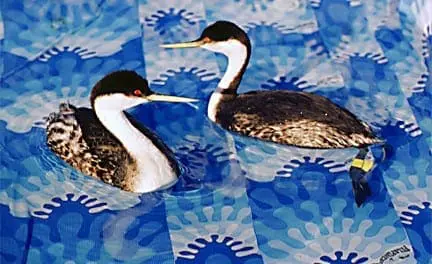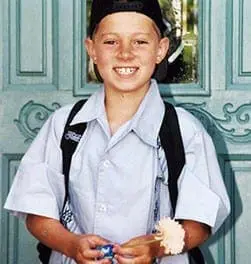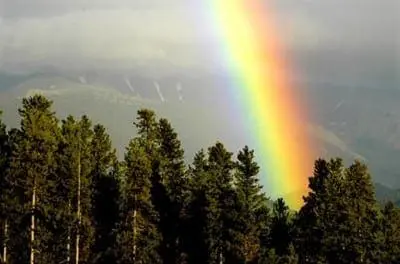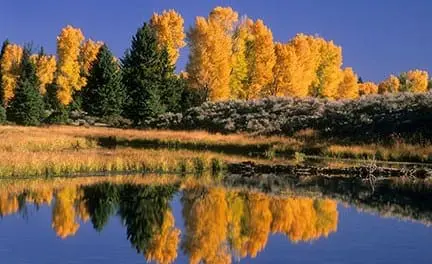DPA Magazine
Patterns and Pools
I was in the middle of photographing our local Wildlife Rescue Group when I came upon these two Western Grebes recovering from injuries in a child′s pool. The juxtaposition of these two floating birds above the blue feather pattern was too much to resist. Shooting for local non-profits can sometime produce rewards beyond that of helping a worthwhile cause. © Chuck Place, Los Angeles DPA Instructor
Sun On The Horizon
As a nature photographer, sunrise and sunset are my primary times to shoot. I love the “sweet light” these two times of day provide. The color and quality of sweet light is unrivaled. The warm glow, the sidelighting, and the vibrant and saturated colors they impart can’t be had at any other time of day nor can they be faked in Photoshop. Every sunrise and sunset is different and the more you get out to shoot at these times, the more you’ll understand what I’m saying. There are many ways to exploit the sun’s effect at sunrise and sunset. First, when clouds accompany a sunrise on the eastern horizon or a sunset on the western, vibrant color may enhance your subject. Second, take advantage of the sweet light falling upon the landscape bathing it in golden tones of yellow, red and orange. Finally, and the focus of this article, is photographing the sun when it’s on the horizon. As a subject unto itself, unless the color in the sky is electric, you’ll find it’s better to include an additional element to add intrigue to the photograph. In that the sun is a very bright source of illumination, unless it’s dramatically diffused, backlit subjects that are included in the composition will reveal little or no shadow detail. With this in mind, finding an interesting silhouette will greatly enhance the impact of the photograph. The more graphic it is, the better. For instance, an outline of a rectangular building will be rendered as a large black blob whereas an old leafless cottonwood will be much more pleasing. Equally as important as the choice of silhouette is where you place the sun and the main subject. Avoid compositions where both appear in the center. Try to use the rule of thirds as often as possible for both the sun and silhouette. There are concerns that need to be addressed if you plan to add this technique into your repertoire. First and foremost, avoid looking directly at the sun through your viewfinder, especially if you’re shooting with a telephoto. You need to squint and look at other parts of the frame when you create the composition. If there are no clouds to soften its intensity, this becomes even more critical. In situations like this, wait until the sun is almost touching the horizon. To get the proper exposure, take a meter reading without the sun in the frame and use this as your base point. After taking a photo with this reading, check your histogram to make sure you don’t clip either the highlights or shadows. If so, compensate accordingly. You may find that the exposure will rapidly change so check your histogram often to make sure you don’t lose detail in important areas. To learn more about this topic, join me on one of my Photographic Nature Tours. Visit www.russburdenphotography.com and click on the NATURE TOURS button for more information. Also, pick up a copy of my new book, Amphoto’s Complete Book of Photography. You can purchase a signed copy directly from me or visit your local book store or Amazon. Contact me at [email protected] to order your signed copy.
Your Child′s First Day of School
To get great shots of your child′s first day of school, shoot both candids and posed shots. For candids, I suggest you try capturing the moments when your sons or daughters are organizing their backpacks, primping themselves in front of the mirror, giving goodbye hugs to mom and dad, getting ready to walk out the door, and ambling away toward the school bus. Reserve time to make a posed shot when your kids are all dressed and ready for their big day. Every year I′ve taken a snapshot my son by the front door of my home. It′s become an annual tradition that′s both sentimental and meaningful. Make the morning of your child′s first day of school low key. For many kids, it can be a very stressful time. Constant reassurance that everything will be OK will help comfort them. While your spouse or one of your other children is doing this, photograph these tender moments. Try to capture the feeling as hugs and smiles are shared. Pump up the ISO on your digital camera and try shooting some pictures without flash. If it can be arranged, try to introduce yourself and your child to the teacher before the new year starts. Before my son entered Kindergarten, we did this. I got permission from his teacher to take some photos on the first day of school. In that my son felt comfortable having met her a few days before the year started, it lowered his stress and made it easy for him to pose with her. By the time he came home, I had the photo processed. Seeing the image allowed him to more easily identify with her and it also made a very memorable photo. Lastly, wait at the bus stop when your child returns from that first day as he or she steps off and runs to you with a big smile and open arms.
Get Great Halloween Pictures
Halloween is a great holiday for photography. Kids parade the streets in colorful costumes, decorative lights add an eerie glow to the neighborhood, festive decorations adorn houses, and groups of trick or treaters await the eager photographer ready to capture the festivities. Costume clad kids become the centers of attention as parents across the US help apply make-up, adjust a mask, engineer a make shift prop, or simply sit back and watch their kids undergo transformations from their normal beings only to be recognized by their voices. These are the moments for which photography was created. The majority of Halloween pictures are made after dark necessitating the use of flash or high ISO settings. Flash works well if the action is fast and you need to freeze the moment. If there′s a significant amount of ambient light in your home, setting the ISO on your digital camera to 800 will allow you to capture natural light shots. Light from a flash creates natural color while pictures lit with incandescent bulbs give the image an orange / yellow hue which may act to enhance the scary colors of Halloween. A photographic technique I like to use for Halloween shots is slow shutter synch with flash. In the accompanying image of my son next to the jack-o-lantern, I used a one second exposure to record the candlelight inside the pumpkin along with the lights inside the house. During the exposure I intentionally moved the camera creating the blurs of light. The reason my son is sharply recorded is I had him hold still during the exposure. The flash fired at the end of the one second exposure and recorded the sharp detail in the image.
How to Photograph Rainbows
There’s nothing like dramatic light to take a scenic that’s been shot thousands of times to a new level. Impending storms, shafts of sun spotlighting key compositional elements, fire engine red clouds, all qualify but what rides highest on many landscape photographer’s list of most dramatic are rainbows. They have it all - prismatic color, a stormy sky lit by the sun, early morning or late afternoon light, and if you believe in folk tales, maybe a pot of gold. They’re adrenaline pumping phenomena that rev up many photographers’ juices. With each rainbow I’ve encountered over the years, upon completion of the shoot I look to the sky, wink, say thanks, and rush back to the motel to burn a CD and place it in a safe location. Finding a rainbow requires a number of natural events to occur. First off, the horizon by the setting or rising sun must be clear and the sun needs to be lower than forty two degrees in the sky. With your back to where it rises or sets, turn so your shadow falls directly in front of you so you’re facing one hundred and eighty degrees from the sun. The point at which you now face is known as the antisolar point. This is where the arc of the rainbow will appear providing there is moisture in the sky. When all factors come together, a rainbow materializes. Understandably, they’re not an every day occurrence. When you’re out in the field and it’s rainy, look toward the horizon of the setting or rising sun. If you see an opening in the clouds, look for a foreground in the direction of the antisolar point that has character or interest and wait. Mount your camera to a tripod to ensure you get a sharp image. If a rainbow shows up, make sure you capture it exhausting all compositional possibilities. Shoot it vertically, horizontally, with a wide angle to take it all in, and with a telephoto to sample portions with the most dramatic color. Use a polarizer to enhance its color but be careful because as you rotate it, you can also eliminate it. Don’t dwell on this as it’s visible through the viewfinder. Join me on one of my photo tours and I will hopefully be able to show you how to photograph a rainbow first hand. www.russburdenphotography.com
How to Photograph Fall Foliage
Autumn is my favorite season in which to photograph. A refreshing and invigorating chill permeates the air, and the warm colors of the season, combined with the low angle of the sun, make for extraordinary photographic opportunities. Although the best light occurs at sunrise and sunset, good pictures can be made during mid day hours by concentrating on close ups and backlit leaf studies. As with any photographic journey, the first step is to research the location. You need to know when the foliage usually reaches peak color. Just because peak color occurs in the beginning of October where you live, it doesn’t dictate this is the norm elsewhere. Factors such as altitude, latitude, and micro climates all impact when the leaves in a given area turn. The Chamber of Commerce and the internet are excellent resources. Additionally, foliage hotlines are set up during the season. Many photographers think of the grand landscape when it comes to taking pictures of fall foliage. They are glorious and make gorgeous post card type shots, but don’t overlook the smaller aspects of autumn. A single tree in peak color is a wonderful autumn subject. Move in closer to isolate a colorful branch juxtaposed against a polarized blue sky to create an abstract. Getting even closer, photograph a few leaves or even a single leaf showing its vein patterns. Additionally, while many photographers concentrate on looking up at the color on the trees, I want you to look down on the ground for interesting patterns of fallen leaves mixed in with pine needles and cones. Quite often the "intimate landscape" can net an image with greater impact than the grand one. Backlit leaves take on a glow making them pop right out of your photographs. Try to look for this as much as possible. Take a 360 degree walk around an isolated tree and notice the difference between the leaves when they′re frontlit vs. backlit and you’ll see what I mean. Metering a backlit scene can be a bit tricky so I suggest bracketing your exposures. Also, lens flare will occur more readily so make sure you shade the front element. For information about fall foliage nature photography tours, visit my website at www.russburdenphotography.com.
Sunset on Songo Pond, Bethel Maine
For this image of a sunset on Songo Pond, I made sure to set the TZ-3 so the flash was forced off. The silhouette of the tree helps create a sense of scale and place. I also gave the shot more weight to the bottom, creating a sense of the distance of the mountains. Wait until the right moment when the sky might seem just a bit too dark, which can give you richer colors, then make sure to steady the camera on a tripod, railing or anything handy since the shutter may be up to 1/2 second. Since the TZ-3 has built in stabilization, it′s also possible to be very still and hand hold the camera, as I did in this photo.
Michael in the canoe, Maine
For a fun alternative, I used a very low angle, tipped the camera and switched to black and white. Try new ways of looking at a subject...don’t even look through the viewfinder. Black and white and other alternative color settings on the TZ-3 can make an ordinary photograph look creative.
Balancing the family vacation and photography
Photography is a lonely art. It is best practiced when you have time and light. But doesn’t it seem that it is only on vacation that we have time and light AND a mind that is more relaxed and open? Travel or vacation photos are a source of great memories and inspiration. They offer an opportunity for a change of scenery, a different pace in which to create, and hopefully the time to follow one’s instincts or interests. However, when on a family vacation – with significant others, perhaps a child or two in tow- how can you have your own creative agenda and meet the expectations of the family? There are several ways to do this. One is to include the family in the photos. Have children play on playground equipment, play hide and seek in a park, or treat them to a banana split – all can lead to new picture ideas. Have a significant other read in the park, or run up the hill and follow with your camera. Have family members shop in the street market and photograph them while they barter or deal with a new currency. Or send them off on their own to allow you time to do your own photographing and exploring your photographic curiosities. Place a time limit on yourself. Tell the family, “ I will meet you in 90 minutes”. Then go off, but be sure to be back on time. Perhaps they might like a day on their own to explore maritime museums or to go sailing while you prefer dry land. You can also get up extra early and go out for an hour on your own as the sun rises for that special light or go out after dark and wander an hour while the family stays put in their campsite or hotel room. Finally there are photos to be made while wandering with the family. Have your camera with you, but keep in mind that your priority is being with your family in your new environment. Include them in pictures or ask them to pose a certain way for you. They may tire of that but while they sip a cold drink, try different exercises. Can you make an abstract photo from that scene? Can you record that break as a journalist might? Or make it a graphic image? Enclosed are two photographs made on vacation with family. One was made while a traveling companion was just around the corner, and one was inclusive on a walk. The first photo: Domme afternoon, was taken in the small town of Domme in the Dordogne region of France. It was taken with a Panasonic DMC-TZ3 with the color set for sepia tone. My vacation partner was around the corner and this town seemed to cry out for sepia. The second photo was taken in Vitrac another small town in the Dordogne region of France. This photo includes my travel partner who gets tired of posing and being asked to move this way or that way; here she could just enjoy the walk in the woods. She is included, but not as a collaborator. This photo was also taken with the Panasonic DMC-TZ3 with the color mode set to black and white.
Tumbledown Mountain, Weld Maine
Leading lines are a great way to draw attention to the subject you want to highlight. In this case, I used the cracks in the rocks and the green scrub brush growth to lead the viewers eye to the mountain top. By also putting the mountain in the top one third of the photo, the composition is more pleasing and it gives emphasis to the leading lines of the foreground rock.







